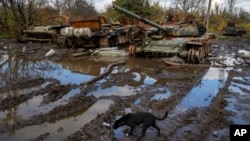At a meeting with the directors of Russian defense plants on March 23, former Russian president Dmitry Medvedev read out Soviet dictator Joseph Stalin’s World War II telegram to their predecessors, threatening to "crush” them “like criminals" if the factory missed production targets. Russia has only one battle tank manufacturer, UralVagonZavod, which has two plants located in the Siberian cities of Omsk and Nyzhny Tagil.
After that meeting, Medvedev gave interview to Russian news agencies claiming the Russian army had not had and would not have problems with supplying weapons for the war with Ukraine:
“Our enemies thought that our industry would be overwhelmed. … There were endless claims: munitions are running out, tanks are running out, missiles are running out. We will build a thousand and a half tanks alone this year.”
That claim is likely false.
Military experts: Russia will not be able to produce 1,500 tanks in 2023
Before Russia launched its full-scale invasion of Ukraine in February 2022, most military analysts estimated that the country could produce no more than 250 tanks per year. Following the invasion, Western bans on supplying high-tech military items to Russia exacerbated the situation. To compensate for the loss of thousands of tanks in Ukraine, Russia is refurbishing tanks manufactured in 1950-1960.
In recent years, Russia has been producing about 250 tanks a year, according to an April 2022 estimate by Mark Cancian, a senior adviser at the Center for Strategic and International Studies, a Washington-based think tank.
The Insider, a Latvia-based Russian independent online media outlet, reported in August 2022 that Russia produced or modernized approximately 205-220 tank units per year from 2011 to 2020:
“[N]o more than 160–170 units of T-72B3/B3M per year in 2011–2020 from the Uralvagonzavod (UVZ) plants in Nizhny Tagil and Omsk ... and no more than 45–50 units of T-80BVM in 2017–2021 from a plant in Omsk,” wrote military analyst Pavel Luzin. Serial production of T-90M tanks began only at the end of 2021 and totaled several dozen a year.
According to Novaya Gazeta Europe, another Latavia-based Russian media outlet, the Russian defense industry currently produces no more than 250 new tanks a year.
“Our source working for one of the state corporations in Russia estimates the current Uralvagonzavod’s production capacity at 200–250 tanks a year,” the publication reported last November.
Britain’s The Economist reported in February that Russia could produce only 240 tanks per year, and that the number could decrease due to sanctions on military and dual-use products:
“Russia has only one tank factory left: UralVagonZavod, a huge complex built in the 1930s. But financial mismanagement and huge debts have slowed modernization. … Russia can only build 20 new tanks a month … And production may be hampered by shortages of parts. Semiconductors, the computer chips that control modern tanks, are in particularly short supply.”
The Ukrainian publication Defense Express ran an article on March 25 headlined: “Russia’s Dreams of Producing 1,500 Tanks a Year as a Loss of Reality: What Is the Maximum the Kremlin Can Count On.”
It reported that in 2021, the Russian Armed Forces received only 250 new or upgraded main battle tanks. In 2022, Russia put its factories on round-the-clock shifts and introduced norms similar to those imposed during 1918-1921, the period of “War Communism.”
“[A]s reported by Russia’s Minister of Defense Shoigu himself: draconian methods led to only a 30% increase in the production of weapons and military equipment in 2022,” Defense Express wrote.
If Russia could produce 1,500 tanks a year, it would not be refurbishing obsolete tanks
Since last February, the Russian army has had losses in Ukraine estimated at between 2,000 and 2,300 tanks, around half of its best tanks, according to the International Institute for Strategic Studies, a U.K.-based think tank.
To compensate for the loss, Russia is refurbishing tanks manufactured in the 1950s and1960s. According to the Conflict Intelligence Team, an independent Russian organization, these include obsolete Soviet T-54 and T-55 tanks, the development of which began before the end of World War II.
In an interview with Current Time, a television channel produced by Radio Free Europe/Radio Liberty (RFE/RL) in cooperation with the Voice of America, Ukrainian military expert Alexei Getman said that the restoration of old tanks show that new tanks are in short supply:
“They [the Russian army] lack heavy equipment, including tanks.…
Russian industry today can produce no more than 20 tanks per month — these are more or less modern tanks. Therefore, they have long since begun to reactivate what they had. First, the old tanks, which were 30-40 years old, now the turn has come to tanks that are more than 60 years old. I think that they will not stop there and will raise, perhaps even the T-34s that they still have.”
According to RFE/RL, Russia transported old Soviet equipment en masse to battlefields in Ukraine last fall, with trains carrying refurbished T-62 tanks, originally produced 50-60 years ago.
“It is difficult to name the possible areas of application of these tanks, but in any case, … this indicates serious problems in providing the armed forces of the Russian Federation with military equipment,” the Conflict Intelligence Team reported.
Forbes reported in March that it was "a deeply ominous sign for Russian tank crews" that the Kremlin had begun restoring 70-year-old T-54 and T-55 tanks "40 years after the Soviet army retired the types."
Additionally, Jakub Janovsky, a commentator for the military tracking website Oryx, told Polygraph.info that “Medvedev is delusional. The production of newly built Russian tanks is IMO unlikely to exceed 300 in 2023. Additional: approximately 500 older tanks might be modernized, but we are already seeing such ‘upgrades’ involve inferior/old components … which isn't exactly impressive in 2023.”





